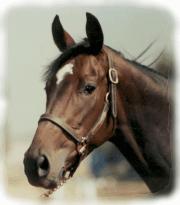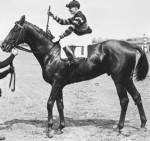
A Horse, of Course with Don Blazer |

A Legend By Don Blazer copyright©2016 Originally published in 1974 Success Is Easy/Don Blazer A Legend Only under very special circumstances or in a fit of sentimental foolishness would a man refuse to put a price on a horse. Samuel D. Riddle might have been guided by both. He had a colt he’d paid $5000 for as a yearling, yet he turned down William T. Waggoner’s offer of $500,000. And when the Ft. Worth Texan offered $1 million, Riddle turned that down, too, and when Waggoner handed Riddle a blank check, Riddle refused it, saying, “The colt is not for sale.” Riddle may be the only horseman in history who did the right thing by not selling. Certainly he was correct in saying you can’t put a price on a legend. And he should have known. He owned one. The colt he refused to sell in 1920 was recognized as the standard by which all other race horses, at that time, were measured. You see, as a three-year old, the colt held North American race records at one mile, a mile and one-eighth, and a mile and five lengths. It’s true all the records have been broken, but not by horses running on the same type of tracks or with steel racing shoes. Today’s race tracks are faster than the tracks of the ‘20’s, and steel shoes are much heavier than the aluminum plates used today. This emerging legend not only set the records, but he did it carrying weight. Today’s two-year olds seldom carry more than 122 pounds, but on six occasions, this cold carried 130 pounds. Once, as a three-year old, he carried 138 pounds on a heavy track. He won easily. As a matter of fact, most of his victories were easy. His margins ranged from one length to 100 lengths. He ran so well that challengers were hard to find. More than once he ran in races which turned out to be matches, even though they weren’t planned that way, and he did win the only real match race arranged for him. In 21 career races, he lost only once, and that was to a horse he defeated on four other occasions. The loss was described by most racing experts as due to a bad ride and poor racing luck. The big chestnut was a giant in his day in more ways than one. When mature, he measured 16.1 and five-eighths inches, and weighed 1,100 pounds while in race training. After retiring to stud, his weight went up to 1,300 pounds. His heart-girth measured 71 and three-quarters inches, and his stride was estimated, although never officially measured, at between 25 and 28 feet. He was a kind, but never quiet, horse. He was tense, excitable, and quite playful. One of his favorite games was to snatch the hat off his exercise boy and then trot around his stall challenging the boy to recover the hat. His nervousness was evidenced by one bad habit. While lying in his stall, supposedly resting, he would chew on his hooves. When humans do this, we call it “biting our nails”. At stud, he was more than outstanding. He was the first horse, ever, to command a fee of $5,000. He sired 379 registered foals, most by less than spectacular mares, but even so, more than half were race winners. Two of his sons won the Kentucky Derby, and one won the Triple Crown (War Admiral). Our legend didn’t run in the Kentucky Derby, but he did win the Preakness and the Belmont Stakes. He stood at stud for more than 20 years, and he had thousands and thousands of friends and visitors. He was foaled on March 29, 1917, and he died at the age of 30, on November 1, 1947. He was known to the racing public as “Big Red”. He was described by his long-time groom, Will Harbut, who died shortly before the champion, as “de moistest hoss dat ever was.” His legendary name is in the record books as Man O’ War. * Earn a degree in equine studies, or certification as a horse trainer, riding instructor or stable manager. Go to www.horsecoursesonline.com for more information. Each month you'll find a new column on our web site. We hope you'll enjoy it, and maybe e-mail us with questions or suggestions for other columns. A Horse, Of Course is a monthly column syndicated by Success Is Easy. If you like the column, call your local newspaper, or local horse publication and ask them to subscribe by contacting Success Is Easy. |
